Gas fire extinguishing system using bi-gases
Various hazards cause fires in the environment. Gas fire extinguishing methods in
They are used when they may be used due to the high sensitivity of the environment
Damage water and foam to the equipment in the environment.
Firefighting Equipment Guide
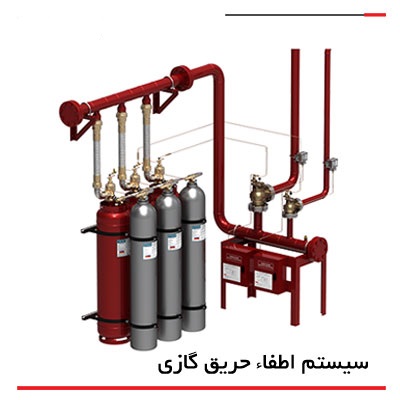
Types of gas fire extinguishing systems
Gas fire extinguishing systems fall into two general categories, systems
Carbon dioxide gas fire extinguishing and gas fire extinguishing system by clean agents
They are divided, which we will introduce in the following.
Co2 gas fire extinguishing system
Carbon dioxide (Co2) gas fire extinguishing system method
It is effective in extinguishing fires. In this method due to the fact that oxygen is one
From the 3 sides of the fire triangle, try to reduce the amount by increasing carbon dioxide
Oxygen is released into the environment and eventually the fire is extinguished.
One of the weaknesses of this method is its destructive effect
He pointed to the environment, which reduces the popularity of this method and trend
Organizations are safe using fire extinguishing systems.
One of the safe fire extinguishing methods is to use clean agents, which are described below.
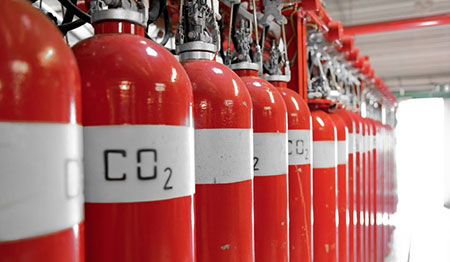
Gas fire extinguishing system with clean agents
In the gas fire extinguishing system by clean agents, the gas
Safe substances that are not harmful to human health and the environment are used,
In this regard, it can be pointed out that these gases prevent
They have a destructive effect on the ozone layer. Gases as agents
Clean in the gas fire extinguishing system are used to three categories of noble gases or
Inert, halocarbon and tip gas are divided into 1230. Below is an introduction to each
We pay:
Noble gas fire extinguishing system
Fire extinguishing system of noble gases or inert gases
There are different types, each of which has a different combination depending on the type
It is composed of inert gases such as argon, carbon dioxide and nitrogen.
Inert gases take up a lot of space, and so on
The reason for their holding cylinders is larger. From another
The characteristics of this group of gases can be attributed to the long activation time
cited.
Inert gas fire extinguishing systems are of the following types:
- IG01 gas fire extinguishing system: consists of argon gas and its mechanism of action is oxygen reduction.
- IG55 gas fire extinguishing system: It is composed of an equal combination of argon and nitrogen and its mechanism of action is oxygen reduction.
- IG100 gas fire extinguishing system: consists of nitrogen
And by removing oxygen causes fire extinguishing, a noteworthy point in
The connection to the IG100 gas fire extinguishing system is to be used over
The limit of it causes suffocation. - Gas fire extinguishing system (INERGEN) IG541: Included
It is a combination of nitrogen, argon and carbon dioxide, which is the percentage of nitrogen gas
More and less carbon dioxide.
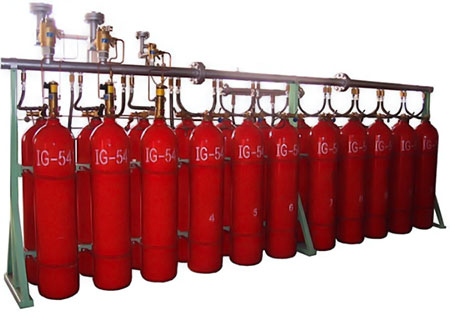
Novec Gas Fire Extinguishing System 1230
Novec1230 fire extinguishing system, due to lack of effect
Environmental degradation is one of the methods of extinguishing clean gas fires
River. How the 1230 gas tip fire extinguishing system works by removing the heating agent
And causes an interruption in the fire process. This extinguishing agent
Fire is stored as a liquid, but is released as a gas.
Halocarbon gas fire extinguishing system
Agents used in halocarbon fire extinguishing agents
They are clean and have no toxic properties. Holocarbon insulated against electric current
And its activation time is less than 10 seconds. This method includes the following types
Is.
- FM200 Gas Fire Extinguishing System: Fire Extinguishing System
FM200, also known as HFC-227EA, is a good alternative to halon gas
Halon gas has a destructive effect on the environment. Combination
Its chemical is HeptaFluoro Propane and through refrigeration and
The cold it generates reduces heat and extinguishes the fire
It is applied through fixed piping and nozzles in any environment. - HFC-125 Gas Fire Extinguishing System: This system as well
It is a type of halocarbon fire extinguisher and causes fire extinguishing by removing heat
Be. HFC-125 is a colorless, odorless gas that does not conduct electricity
However, this gas has physical properties similar to halon but causes it to disappear
It does not become an ozone layer.
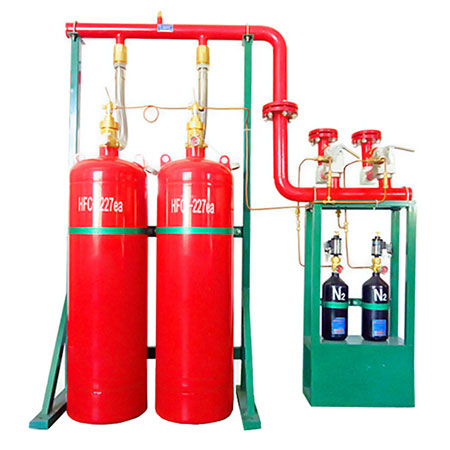
Components of gas fire extinguishing system
Each gas fire extinguishing system consists of the following three parts:
Source or cylinder in which the fire extinguisher is located.
Pipe and nozzle that transmit gas inside the source.
Fire extinguisher system boot
It is worth mentioning that on each of these pipes and sources, different types of valves and nozzles are placed.
How gas fire extinguishing works
This is how gas fire extinguishing works
The extinguishing agent covers the whole environment and creates a high density
The so-called suffocates the fire or it can be localized so that only zinc
Use a specific area.
Application of gas fire extinguishing system
- Electrical and control room
- Data centers and servers
- Imaging centers
- Museum
- Instrumentation CenterArchive of documents and library
- Powerhouse
Advantages of gas fire extinguishing system
- After performing the fire operation, the remaining materials in the capsule can be consumed.
- The annual charge is made only when the material inside the capsule is completely used up.
- The gases used in the gas fire extinguishing system are safe and cannot be combined with other gases.
- The gases inside the capsule do not lose their properties over time.Firefighting operations are performed at high speed.
- No waste remains in the environment after the firefighting operation.
- There is high flexibility in designing a gas fire extinguishing system.
- The cost of purchasing, installing and repairing a gas fire extinguishing system is low.
- The gas fire extinguishing system has no detrimental effect on the environment and the ozone layer.
Design of gas fire extinguishing system
Design of all gas fire extinguishing systems such as
FM200 to factors such as cylinder discharge time, room temperature, fuel source type, class
Fire and hazard monitoring in the environment. Cylinder discharge time must be
In such a way that 95% of the concentration is dispersed in the environment in less than 10 seconds.
Comparison of types of gas fire extinguishing gases
Inert Gas A lot more space than other gases
Occupies and then ranks carbon dioxide, FM-200 and halon respectively
The next ones are.
Comparison of gas and water fire extinguishing systems
Sometimes the use of fire extinguishing systems
Blue causes damage in places like the library, to prevent this
Problem When facing a fire, a gas fire extinguishing system is used. System
ح Gas fire extinguishers are activated in a minimum of 10 seconds and cause extinguishing
They catch fire.
When the blue fire is extinguished, after
Completing the firefighting operation takes a long time to make the environment clean and usable
But if the gas fire extinguishing method is used, the environment after the operation
Extinguisher is usable and requires time to restart
that’s not. It should also be noted that the gas fire extinguishing system in all environments
It is considered the most cost-effective and convenient, when extinguishing a water fire
Not applicable in all organizations.
| Property | Blue fire extinguishing system | Gas fire extinguishing system |
| The amount of damage due to firefighting operations | Top | Down |
| Extinguishing speed | medium | Top |
| has it | has it | does not have |
| Reliability | medium | Top |
| Application in different spaces | does not have | has it |
Gas fire extinguishing system price
The price of gas fire extinguishing system depends on various factors
Whether the type of gas is automatic or manual, the concentration of gas and its brand.
Of course, the price of an automatic gas fire extinguishing system is higher than the price of a fire extinguisher
It is a manual gas.
Gas fire extinguishing system using bi-gases
Various hazards cause fires in the environment. Gas fire extinguishing methods in
They are used when they may be used due to the high sensitivity of the environment
Damage water and foam to the equipment in the environment.
Firefighting Equipment Guide
Extinguishing materials:
Materials that are used as fire extinguishers fall into 4 categories. Due to the need for speed and increase the coverage of extinguishers, two or more extinguishing elements can be used simultaneously. Naturally, each of these materials has advantages and disadvantages in extinguishing various types of fires.
The classification of these materials is as follows: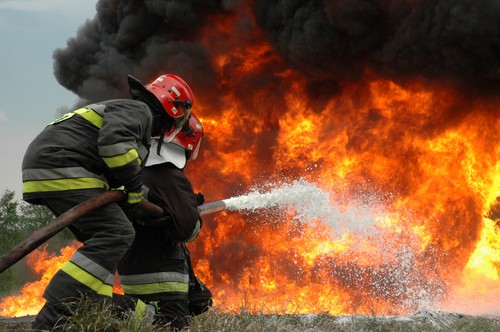
(ACoolants such as water and CO2 gas
(B Suffocating materials such as soil, sand and CO2 foam
(C Air thinners include CO2 and N2
(D Substances that limit chain reactions such as halenes and special powders
– Water:
Using water to control fires is one of the simplest and most effective ways that everyone is familiar with. As much as the use of water can be useful in extinguishing a fire, it can also be dangerous in the misuse of fire and the spread of fire or damage.
The benefits of water
1- It is abundant and cheap, especially since it does not need complete purification for this purpose.
2- Expensive on the bottom and easy to transfer and flows easily in metal, rubber and tarpaulin ducts.
3- It has a high heat capacity, which makes it a desirable coolant. The heat capacity of water is 5 times that of aluminum and 10 times that of zinc and copper. More importantly, the latent heat of evaporation of water is very high and absorbs a lot of heat during evaporation.
4- It is non-degradable by heat, it does not decompose even at high temperatures. At 2,000 degrees Celsius, only one-tenth of its molecules decompose.
5- It has a high cooling capacity so that in equal volume, it is 6.5 times cooler than CO2. Each liter of water can absorb about 550 kcal of heat during evaporation, and each cubic meter of water absorbs about 10,000 kcal of heat to increase the temperature by 10 degrees Celsius.
Disadvantages of water
1) It is heavy, so it is difficult to transport in mobile extinguishing.
2) is a conductor of electricity, in places where there is electricity, increases the risk of electric shock.
3) Water has a risk of destruction, when water is sprayed under pressure, it has a high destructive power, which is sometimes not less than the fire itself.
4) When extinguishing a fire, materials and products are damaged by mixing with water. Such as medicines, furniture, packaging cartons, paints and manufactured products.
5) Due to the increase in the volume of water when evaporating when spraying on flammable liquids such as oil or oil, it causes the liquids to be thrown, exploded and sprayed, causing the fire to spread.
6) Due to the surface tension of water, its penetration into the material piles (coal piles, sawdust and the like) is limited.
– Fire floor:
The foam is prepared as a solution. When sprayed, the foam is mixed with air and water by the head of the foam pipe and bubbles.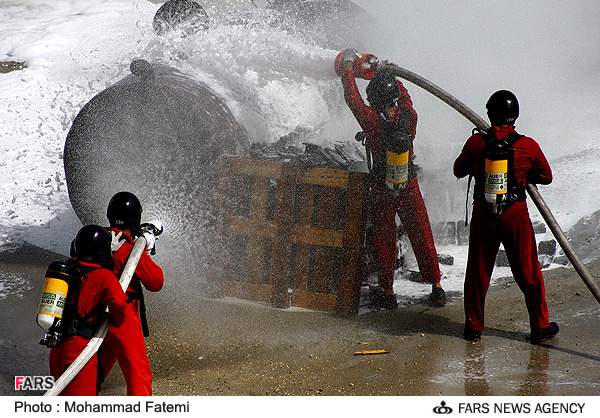 The important point in using the floor is its good development and spreading on the surface of combustible material, especially flammable liquids due to its lightness.
The important point in using the floor is its good development and spreading on the surface of combustible material, especially flammable liquids due to its lightness.
Extinguishing powders:
Using some chemicals, which are usually based on carbonate, sulfate or phosphate, is a common and simple way to put out a fire by suffocating it. These compounds are easily used to extinguish groups C, B, A fire. For this reason, in general use, this extinguishing compound is usually recommended. These compounds are called chemical powders. Although chemical powder is used for Class A fires, it is not recommended for economic reasons unless flammable materials are expensive or the use of water changes their nature.
– Chemical powder:
This powder is sprayed on the fire to cover the fire and prevent oxygen from reaching it.
Powders do not have good stability at temperatures above 60 degrees Celsius and the possibility of their adhesion in the capsule increases. The diameter of the powder grains, depending on the type of material and the manufacturer, is about 10-75 microns. The smaller the particle diameter, the more effective the powder. The chemical powder under the pressure of nitrogen or CO2 is sprayed on the surface of the fire base and if the people are well trained, they can easily put out the fire.
– Dry powder:
This powder is used to extinguish fires of flammable metals such as sodium, potassium, magnesium and the like.
– Gas: CO2
Carbon dioxide is a non-combustible, odorless, non-toxic, and heavier-than-air gas that has a density of 1.5 and is not an electrical conductor. The mechanism of action during a fire is three ways: first, to suffocate the fire by forming a heavy layer resistant to the passage of air, second, to dilute the oxygen in the air around the fire area, and third, to cool the fire.
One of the important properties of CO2 gas is that it does not cause damage to materials in the fire environment, so in cases where valuable materials catch fire, it is more suitable than water. CO2 is very suitable for electric fires because of lack of electrical conduction and lack of materials The residue does not cause binding or damage to sensitive materials.
– Halogenated compounds (halen):
Hallen can play a very effective role in extinguishing without leaving destructive and residual effects on materials and devices. The mechanism of action of halen is somewhat similar to that of CO2, and because they are heavier than air, they can quickly cover the fire and prevent oxygen from reaching it. In addition, spraying these materials on the fire can dilute and inhibit oxygen in the air around the fire. These materials weigh 2 to 3 times as much CO2 as their extinguishing power.
Hallen can slow down chain reactions when exposed to fire and more effectively contain fire, so under the same conditions for extinguishing a fire, the amount of halen required is less than a quarter of the amount of CO2 required to extinguish. Hallen is widely used for small but important areas of flammable equipment or materials such as electronics and electrical machines, high solids fires, dispatching sites, telecommunication centers and the like.
